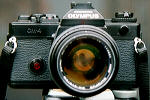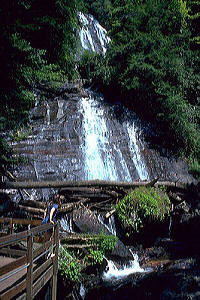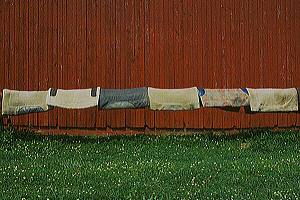
|
Lenses and Photography |
History and Evolution
The Olympus OM system is a series of entry level and professional grade manual focus, manual exposure and aperture priority AE 35mm SLR bodies. The bodies are complemented with an extensive line of Olympus Zuiko lenses.Bodies
The Olympus system began with the M-1 in 1972, later designated the OM-1 in 1973 to keep from running afoul with similarities to Leica's trademarked "M" system numbering. "OM" stands for Olympus Maitani; the company manufacturing the camera and the lead design engineer. The OM-1 was a manual focus, manual exposure, mechanical shuttered SLR with integral TTL metering. With a mechanical shutter, the only reason (and requirement) for a battery was to power the meter. Everything else on the camera body can be operated without a battery. This was followed several years later by an electronic shutter, aperture priority AE and manual mode OM-2 in 1975.Evolution of the mechanically shuttered, manual exposure, integral TTL meter bodies:
Evolution of the electronic shuttered, aperture priority AE (with manual override), TTL meter bodies:
- M-1 and OM-1 (OM-1 without motor drive capability): 1972
- OM-1 MD (OM-1 with motor drive capability): 1974
- OM-1n: 1979
- OM-3: 1983
- OM-3ti (current model): 1995

- OM-2: 1975
- OM-2n: 1979
- OM-2S (OM-2sp): 1984
- OM-4: 1984
- OM-4T (OM-4ti; current model): 1987
The short-lived OM-2S offered a "Program" mode in addition to aperture priority AE and spot metered Manual modes. "Program" mode has neither aperture nor shutter speed priority, but selects both based on required exposure and pre-programmed combinations of shutter speed and aperture. My best guess about why "Program" mode came and went (with not only Olympus but several other major SLR manufacturers) is photographers wanted some to control over the AE. Aperture and/or shutter priority allows manipulating aperture (depth of field and selective focus) or manipulating shutter speed (to stop action or blur moving objects). Program mode did not allow this and constricted flexibility professional and serious amateurs wanted.
In addition to the professional grade OM bodies, Olympus also offers an entry level consumer or amateur grade body. The first of these was the OM-10 introduced in 1979. With a standard OM lens mount, all of them accept OM system Zuiko lenses. The number of OM-10's in the used market attests to its popularity and durability. This eventually evolved to:
The biggest difference between these bodies and the "single digit" OM bodies is their ruggedness. They were designed for lighter duty, less hard use, lower cost and to be used primarily in AE mode. As with the OM-2S, the "PC" had a Program Mode.OM-10 Quartz (OM-10 with databack; 1984) OM-G (OM-20; 1983), OM-F (OM-30; 1983), OM-PC (OM-40; 1985), and OM-2000 (current model; unlike its predecessors, it is made by Cosina for Olympus). Two other OM's were made:
These are the forgotten "bastard children" of the entire OM line. Not that they are "bad" but they are not as common as the rest of the OM series. Unlike the others, I know little about them.OM-77AF (OM-707; 1986) OM-88 (OM-101; 1988) Lenses
The only truly critical aspects of a 35mm SLR camera body are:Anything else is a convenience item! If these criteria are met, lenswork will make or break the photograph in terms of hardware.
- light tight, non-reflective film chamber, back, light box and shutter
- accurate shutter speeds
- accurate lens mounting flange orientation to the film gate (area where the film gets exposed) both in distance and in parallelism
- accurate mirror and focus screen orientation so that the distance between the flange and film gate is identical to the distance between the flange and focus screen as reflected off of the mirror (for accurate focusing)
- film back, pressure plate and film gate that holds the film dead flat across the film gate
In the peak years for the OM system (probably the OM-1n and OM-2n) Olympus provided an extensive line-up of Olympus Zuiko lenses covering every standard focal length from 8mm through 1000mm and offering numerous zoom lenses. The most popular fixed focal lengths (e.g. 28mm, 35mm, 50mm, 135mm) often had multiple offerings to cover price points for entry level and professional grade lenses. The biggest difference between the entry level and professional grade lenses (with a few exceptions) was their speed with many entry level lenses single coated; an entry level lens would be slower.
The current line-up of Zuiko lenses has dropped many of the slowest, least expensive primes and all of the zooms except one very fast moderate zoom just released. A browse through the most recent brochure reveals Olympus is catering to the most serious amateurs (semi-pro) and professionals. However, most of the lenses offered at one time or another can be found on the used market. Some thorough searching, patience and careful selection can turn up a desired lens in very excellent or just under like-new condition. The price market on most of the used lenses are reasonable compared to other major SLR manufacturers.
Future
Olympus has chosen to emphasize its P&S and digital line of cameras. Indeed, the Olympus P&S are among some of the better ones in their price range. Unfortunately this has been at the cost of not pursuing the high end SLR market as was done during the 1970's and first half of the 1980's. The line of lenses offered is not as extensive as it once was (the line continues to offer a complete range of the better ones). The future of the Olympus OM system SLR continues to be debated by those on the sidelines. IMHO, Olympus will continue to offer a reasonable system if for no other reason than it needs a high end flagship if it wants to keep a reputation to maintain and grow its market share in the P&S and digital line. In short, any major, serious 35mm camera manufacturer had best offer a serious high end SLR or it will not be perceived by the market as a serious 35mm camera manufacturer. But that is just MHO and is not based on any knowledge about Olympus' market strategies.
Initial System
I bought my first OM body, an OM-10, with an F.Zuiko 50mm f/1.8 single coated standard lens in 1980, a year after the OM-10 began production. It has served me very well ever since. As with most camera bodies from its era, the foam used started to dry rot with age. During 1999 it received a CLA to replace all its dry-rotting foam. It functions now as it did when it was new.Early System Growth
Within a few months after purchasing the the body and standard lens I added:Manual Adapter (allows OM-10 to operate in manual exposure mode) T-20 flash 28mm f/3.5 Zuiko single coated prime lens 75~150mm f/4.0 Zuiko single coated zoom lens Aftermarket 2X teleconverter Vivitar Close-Up lens adapter set Lightweight tripod Recent Additions and Upgrades
This system served me well for general photography until a few years ago when I became a very serious amateur or enthusiast. I no longer have the OM-10 or the original lenses, all of which were sold during early 2000, almost exactly 20 years after they were purchased new. A few years ago I decided it was time to upgrade the equipment towards the upper end of the OM line, something I had wanted to do quite a few years ago, and began by purchasing an OM-4 body. Recently I used the OM-4 for some night photography in sub-zero (Fahrenheit) weather. The severe cold was too much for the Silver Oxide cells and their voltage quickly dropped too low to operate its shutter electronics. This was the second time it happened and the OM-10's electronic shutter operated by the same cells would fare no better. This led to one of the mechanical shutter bodies that can operate in extreme cold, the OM-1n. The OM-2S was added to the stable to provide a spare body with Aperture Priority AE mode. I don't use it in Program Mode, perhaps because I am so accustomed to Manual and Aperture Priority AE modes. In between all this, the array of Zuiko lenses has been growing steadily.Within the past several years the following has been added to my system:
OM-1n OM-2s OM-4 18mm f/3.5 Zuiko MC 24mm f/2 Zuiko MC 35mm f/2 Zuiko MC 35mm f/2.8 Zuiko Shift 35~105mm f/3.5~4.5 Zuiko MC Zoom 50mm f/1.4 Zuiko MC 50mm f/1.2 Zuiko MC 85mm f/2 Zuiko MC 135mm f/2.8 Zuiko MC 200mm f/4 Zuiko MC 300mm f/4.5 F.Zuiko 2X-A Zuiko MC Teleconverter 0.15X 180° Kenko Fish-Eye Auxiliary Lens T-32 flash (2) T-32 flash filter set (2) Bounce Grip 2 (for T-32 or T-20 flash units) 7mm and 25mm Zuiko Auto Extension Tubes Vivitar AT-21 Auto Extension Tube set Bogen 3021 tripod with 3410 3-D head Bogen 3414 panoramic head and 3288 elbow bracket Future Plans
Improved panoramic capability Faster Medium Telephoto (180mm f/2.8) Longer Super Telephoto (400mm f/6.3) 1.4X-A Teleconverter Improved ability to operate off-camera flash

My photography with the OM system covers a range of subjects including:
- Scenic (landscape)
- Architectural
- Panoramic
- Documentary (objects and structures)
- Special Formal and Semi-Formal Events (receptions and gatherings)
- Semi-Formal Portraiture
I have given up almost entirely on C-41 color negative films except for semi-formal portraiture (formal portraits are not my "thing"). For general photography, my favorite is Royal Gold 100 but I haven't used very much in quite a while. With reversal "what you shot is what you get" as the transparencies are the film itself. There is no cropping, dodging or burning unless you print the transparencies which I do on occasion. A print is a photograph of the negative (or the transparency if you print from slides). Just as one controls focus, exposure and color balance using filters when taking a photograph, the printer also does the same. My experience with print processors of C-41 films has been terrible, particularly with color balance. Every time I shoot a roll of C-41 for general photography I am reminded of why I stopped using C-41 by at least one of the prints!
For semi-formal portraits which are intended to be printed from the outset, my favorites are two professional films: Portra 160NC (neutral color) and Portra 160VC (vivid color) and I'm leaning towards the "VC" version of the film. They have the very wide latitude required for portraiture and even the "VC" version which touts more vivid color does not saturate easily. I do not recommend either for general outdoor scenic or landscape use, particularly with lots of sky or very distant background. There is simply too little saturation and any haze will definitely show up as real haze. They are very good however for portraits of people and skin tone reproduction is superb with both!
The preferred film speeds are 64 for Kodachrome, 100 for Elitechrome, and 160 for Portra. Why slower film speeds? I've hear the argument that the newer films have better resolution than ever before. This is true, but even within the newer films, the slower speeds still have the finest resolution. With an OM body and most of the lenses, look at the EV range you have with combinations of aperture and shutter speed. For outdoor daylight photography, the fastest shutter speed is 1/1000th or 1/2000th on the OM-3[ti] and OM-4[T]. The slowest f-stop on nearly all the lenses (except for some of the long telephotos) is f/16. Using ISO 400 film on a sunny day can get you into trouble! You will find yourself being able to use 1/500th @ f/16, 1/1000th @ f/11, or f/8 @ 1/2000th (if you have a "3" or "4"). This allows hardly any control over how much depth of field a particular scene will have. If you want to get to f/5.6 for at least some depth of field control you need two more stops. With ISO 100 you can get to f/5.6 and with ISO 64 you can get to just above f/4. With a camera like the OM SLR there are more choices now to control the depth of field or to stop action. The two will always be a trade-off. The only other method is to use a Neutral Density filter (a neutral gray filter that takes reduces all incoming light) which adds glass to the system reducing contrast slightly and increasing flare risk. With TTL metering, you can press a polarizer into service for this which will knock anywhere from 2 to 4 stops off. (Without TTL metering you would only be guessing at the light reduction which depends completely on rotation of the polarizer).

Metering and manual exposure with the OM-1n is straightforward and simple. The needle on the left side of the viewfinder is easy to use. I will set either the aperture or shutter speed depending on which is more important for the photograph, and then dial in the other. I am not intimately knowledgable on the exact center-weighting used in AE mode on the OM-10, OM-2S and OM-4, but the TTL metering in all three is dead accurate. It does a very good job even under difficult lighting conditions shooting Kodachrome which does not forgive even a 1/3rd stop exposure error.
Each lens has its own personality and there is some variation even among the same model of lenses. This is true for all lens manufacturers. Unlike other lens makers, build quality (fit, finish and durability) is consistently excellent across the entire price spectrum of Zuiko lenses. The less expensive ones are slower and generally single-coated. Their lower cost was not achieved at the expense of build quality. Among the least expensive on the used market is the older 50mm f/1.8 single-coated standard lens. Other than being the slowest 50mm made (not counting a special 50mm macro lens) it has high resolution and very good contrast. The newest of the standard lenses is the 50mm f/1.2 which, in my opinion, is the best (and most expensive) of the 50mm's. It is very consistent at all f-stops with very high resolution and contrast. In between is the discontinued 50mm f/1.4 in at least three variations, one single-coated and the other two multi-coated. The last of the two multi-coated formulations is an exceptional standard lenses.
The less expensive lenses are generally very good. Most of the lower cost is because they are slower lenses and single-coated. The least costly wide-angle primes are often f/3.5 and single-coated. The most expensive lenses are quite excellent; most of the premium paid is for a faster lens. Overall they hold their own quite well with their counterpart manual focus Nikon, Canon and Leica lenses. In general, the multi-coated Zuiko lenses will have somewhat higher contrast than the single-coated version of the same lens. As time went by, Olympus multi-coated more of their lenses. Higher contrast may make a lens appear to have higher resolution, but this may or may not be true. Higher contrast makes the existing resolution more noticeable. My 28mm f/3.5 single-coated Zuiko has decent contrast but less than my multi-coated 50mm f/1.2. The resolution is nearly equal. One must look at slides projected on a large screen to see this.
Lee Hawkins' Web Site (go to his photography area)
[Extensive information about the entire OM system and OM other links.]- Olympus OM SLR Equipment Guide (Unofficial)
[Comprehensive information about past and present accessory/ancillary equipment.]- Olympus Sales Information File (Unofficial)
[Comprehensive information about past and present accessory/ancillary equipment.]- Unofficial OM Zuiko Lens Page
[Comprehensive information about past and current OM Zuiko lenses.]- Olympus Documentation Archive (Unofficial)
[Growing archive of OM documentation including out-of-print instructions.]- Olympus OM System Lens Tests (Unofficial)
[Growing compendium of test results on OM Zuiko lenses.]- The Unofficial Olympus Web Photo Gallery
[Enormous gallery with truly stunning photography, including a number of professionals.]- Unofficial Olympus Special Event Galleries:
[ADITL = "A Day in the Life"; TOPE = Themed Olympus Photo Exhibition]
- ADITL 1 06/21/99 (no theme)
- ADITL 2 09/21/99 (50mm standard lenses only)
- ADITL 3 12/21/99 (no theme)
- TOPE Events
- Olympus Mailing List (Unofficial)
[Home page to the Olympus Users' Group Mailing List with instructions on how to subscribe.]- Olympus OM Webring (Unofficial)
[A Webring linking together web sites devoted to the Olympus OM system]